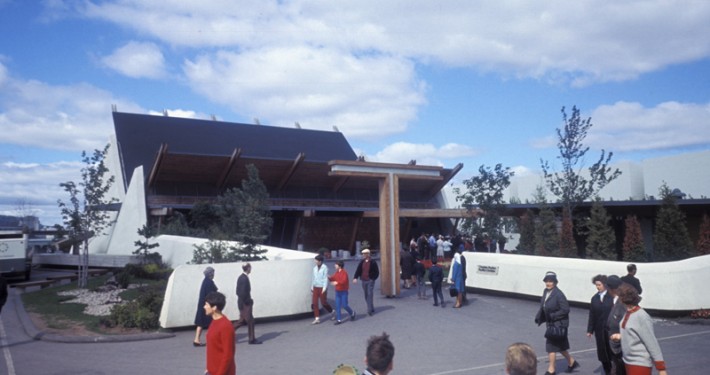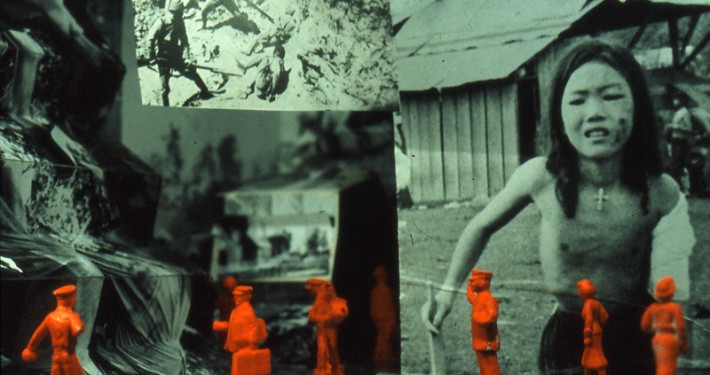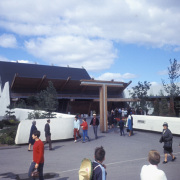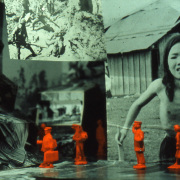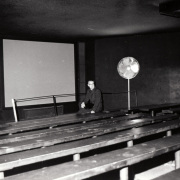The Christian Pavilion and Sermons from Science Pavilion, two of three religious pavilions at Expo 67 (the third was the Judaism Pavilion), both employed conventional single-screen films in 16mm and 35mm in theatres with seated viewers.
The Eighth Day (1967) can be understood as one (moving) screen element amongst hundreds that comprised the multimedia installation designed by Montreal artist Charles Gagnon. Throughout the Christian Pavilion, Gagnon used over three hundred photographs and forty speakers to envelop viewers in images and sounds suggestive of everyday life. The Eighth Day was screened repeatedly in a hundred-person cinema in the pavilion’s lower area. The fourteen- minute, 16mm black-and-white single-screen film draws its title from Christian scripture and refers to the day in which humankind inherits the earth from God. Its construction combines existing newsreel footage and animated still images in a collage technique comprising a frenetic critique of war technologies, violence, and postwar consumer culture. Gagnon began the film in
1966 with the assistance of Judith Trotsky, a New York-based film researcher who located in a variety of newsreel film libraries the very specific footage Gagnon requested. Gagnon’s brilliant editing taps the potential of collage film to create an eerie politicized ambivalence as viewers are barraged with the violence of everyday life. The Eighth Day sits alongside other collage films employing “apocalyptic” archival imagery of wars, disasters, catastrophes, nuclear and atomic bombs – all favourites of the genre.
The Sermons from Science Pavilion screened a program of at least twelve films produced by the Moody Institute of Science from 1946 to 1961. The pavilion was organized by a group of Montreal businessmen and involved volunteers and support from evangelical Christians and organizations in the United States and Canada. The films it presented began in the late 1930s with live performance lectures by Pastor Irwin Moon, whose demonstrations aimed to show how the marvels of science offered visible evidence of a divine Christian plan of creation. In 1945, Moon founded the Moody Institute of Science, and began to emphasize the production of films that supplemented live presentations (later largely performed by George Speake) and could circulate independently.
Moody Institute of Science films were shown in a number of world’s fairs, including the New York World’s Fair in 1964. The pavilion on Île Notre-Dame adapted the programming of the films in New York to Montreal. In a three-hundred-seat, air-conditioned auditorium, with screenings were ongoing throughout the day; live demonstrations included flashlights that talked, liquid light emitted from cold chemicals, and the famous million-volt flash of electricity that passed through a man’s body. A second, seventy-five-seat conference theatre presented a film featuring a call to Christian conversion by evangelist Leighton Ford.
Charles Gagnon (d. 2003)
Charles Gagnon was a Montreal-based multidisciplinary painter, photographer and filmmaker. He made four experimental films between 1967 and 1971. There have been two major retrospectives of his work in 1978 at the Montreal Museum of Fine Arts, and in 2001 at the Musée d’art contemporain de Montréal. His works are in major museums and private collections nationally and internationally. He was the recipient of numerous prizes including the Ordre du Québec in 1991 and Prix Borduas in 1995. He received an honorary doctorate from l’Université de Montréal in 1991, and in 2002 he was the recipient of a Governor General’s Visual and Media Arts Award.

